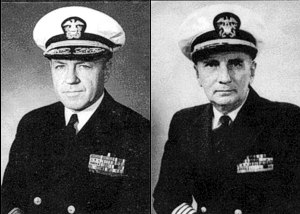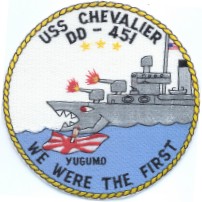
Chevalier had two commanding officers during her short career: Cmdr. Ephriam R. McLean, Jr., USN (as captain, left), who commissioned her and Cmdr. George R. Wilson, USN (also as captain, right), her skipper when she was lost.
Bath Iron Works and Federal Shipbuilding and Drydock Corp., Kearny, New Jersey were the first shipyards to change over construction to Fletchers from Gleaves-class ships. Both yards customarily laid down ships on adjoining slipways in pairs. Thus Fletcher was laid down side-by-side with Radford at Kearny 2 October 1941 and Jenkins and La Vallette followed on 27 November. Before this, however, Nicholas and O’Bannon, Bath hull numbers 190 and 191, had been laid down on 3 March, followed by Chevalier and Strong on 30 April and then Taylor and De Haven by the end of September.
They were all commissioned during the summer of 1942 and the first of them—Nicholas, O’Bannon and Fletcher—were sent immediately to the British Solomon Islands of the South Pacific, where they arrived in time to participate in some of the famous night surface actions of the August 1942–February 1943 Guadalcanal campaign. The others were initially assigned to convoy duty in the Atlantic, then sent to the Pacific at the end of 1942.
In January 1943, Fletcher, Radford, Nicholas, O’Bannon, and De Haven were among the ships that formed Captain R. P. Briscoe’s “Cactus Striking Force” (“Cactus” was the code name for Guadalcanal) operating out of Purvis Bay, near Tulagi. La Vallette was torpedoed on January 30 and De Haven was bombed and sunk off Guadalcanal on February 1.

This USS Chevalier patch was sent to the Navy Archives. Here is its meaning:
DesRon 21 was formed in March, and it was with this squadron in the New Georgia campaign that Chevalier served until she was lost. Early action centered on Kula Gulf, which separates New Georgia and Kolombangara. There, the “Chevy” escorted minelayers and convoys and conducted shore bombardment.
On the night of July 5, Nicholas and Strong led the cruisers of Task Force 18, Honolulu, Helena and St. Louis, into Kula Gulf to bombard enemy shore positions, with O’Bannon and Chevalier at the rear of the column. A Long Lance torpedo fired by an enemy destroyer at a range of more than 11 miles struck Strong, leaving her in sinking condition. Chevalier intentionally rammed her sister ship stayed alongside for more than seven minutes, allowing 247 members of her crew scrambled to safety while the O’Bannon stood by, returning fire as shore batteries began to find the range.
After her damaged bow was repaired, Chevalier continued in service until 6 October 1943 when she, with Selfridge and O’Bannon, intercepted a force of nine destroyers and destroyer transports sent to evacuate troops from Vella Lavella. Although outnumbered, the American destroyers attacked, but Selfridge and Chevalier were both torpedoed. Selfridge lost her bow but survived. Chevalier, unable to maneuver and in sinking condition, was promptly rammed by O’Bannon. In the early hours of 7 October, she fired her remaining torpedoes into Japanese destroyer Yugumo, and after the crew were taken off, was sunk by La Vallette.
Chevalier earned three battle stars.